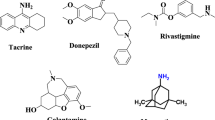Abstract
In vitro studies on cholinesterase inhibitory potential on the three sets of 2,3-dihydro-1,5-benzothiazepines have been carried out. The compounds in Set 1 were unsubstituted on ring A, while those in Sets 2 and 3 had a 2′- and 3′-hydoxy substituent, respectively, in ring A. These studies revealed that they are mixed inhibitors of both AChE and BChE as reflected from their IC50 values. It was further observed that 3′-hydroxy substituted benzothiazepines (Set 3) were found to have stronger affinity for both AChE and BChE compared with those of Sets 1 and 2. Moreover, all the compounds in Set 3 were found to be stronger BChE inhibitors than AChE. These experimental observations were rationalized by conducting in silico studies using molecular docking tool of Molecular Operating Environment (MOE) software, thereby, a good correlation was observed between IC50 values and their binding interactions within the enzyme active site. We have observed that these interactions were electrostatic and hydrophobic in nature besides hydrogen bonding. The high BChE inhibitory potential of 3′-hydroxy substituted benzothiazepines was found to be cumulative effect of hydrogen bonding and π–π interactions between the ligand and BChE. These findings may serve as a guideline for synthesizing more potent ChE inhibitors for the treatment of Alzheimer’s disease and related dementias.








Similar content being viewed by others
References
Abdel-Hamid MK, Abdel-Hafez AA, EI-Koussi NA, Mahfouz NM, Innocenti A, Supuran CT (2007) Design, synthesis, and docking studies of new 1,3,4-thiadiazole-2-thione derivatives with carbonic anhydrase inhibitory activity. Bioorg Med Chem 15:6975–6984
Ansari FL, Umbreen S, Hussain L, Makhmoor T, Nawaz SA, Lodhi MA, Khan SN, Shaheen F, Choudhary MI, Atta-ur-Rehmam (2005) Syntheses and biological activities of chalcone and 1, 5-benzothiazepine derivatives: promising new free-radical scavengers, and esterase, urease, and alpha-glucosidase inhibitors. Chem Biodivers 2:487–496
Ansari FL, Iftikhar F, Ihsan-ul-Haq MB, Baseer M, Rasheed U (2008) Solid-phase synthesis and biological evaluation of a parallel library of 2, 3-dihydro-1, 5-benzothiazepines. Bioorg Med Chem 16:7691–7697
Carolan CG, Gaynor JM, Dillon GP, Khan D, Ryder SA, Reidy S, Gilmer JF (2008) Novel isosorbide di-ester compounds as inhibitors of acetylcholinesterase. Chem Biol Interact 175:293–297
Carreiras MC, Marco JL (2004) Recent approaches to novel anti-Alzheimertherapy. Curr Pharm Des 25:3167–3175
Ellman GL, Courtney KD, Andres V, Featherstone RM (1961) A new and rapid colorimetric determination of acetylcholinesterase activity. Biochem Pharmacol 7:88–95
Esposito EX, Eselli B, Ken K, Jeffry DM (2000) Receptor-binding and down-regulatory properties of 22000-Mr human growth hormone and its natural 20000-Mr variant on Im-9 human lymphocytes. J Mol Graphics Mod 18:283–289
Harel M, Schalk I, Ehret SL, Bouet F, Goeldner M, Hirth C, Axelsen PH, Silman I, Sussman JL (1993) Quaternary ligand binding to aromatic residues in the active-site gorge of acetylcholinesterase. Proc Natl Acad Sci USA 90:9031–9035
Kryger G, Silman I, Sussman JL (1998) Three-dimensional structure of a complex of E2020 with acetylcholinesterase from Torpedo californica. Physiol Paris 92:191–194
Kuntz ID (1992) Structure-based strategies for drug design and discovery. Science 257:1078–1082
Molecular Operating Environment (MOE 2005-06) Chemical Computing gp Inc., 1010 Sherbrooke Street West, Suite 91, Monsteal, H3A 2R7, Canada
Morris GM, Goodsell DS, Huey R, Olson AJ (1996) Distributed automated docking of flexible ligands to proteins: parallel applications of AutoDock 2.4. J Comput Aided Mol Des 10:293–304
Nachon F, Nicolet Y, Masson P (2005) Crystallization and X-ray structure of full-length recombinant human butyrylcholinesterase. Ann Pharm Fr 63:194–206
Nawaz SA, Umbreen S, Khalid A, Ansari FL, Atta-ur-Rehman, Choudhary MI (2008) Structural insight into the inhibition of acetylcholinesterase by 2,3,4,5-tetrahydro-1, 5-benzothiazepines. J Enzyme Inhibit Med Chem 23:206–212
Rodriguez MI, Fernendez MI, Perez C, Castro A, Martinez A (2005) Design and synthesis of N-benzylpiperidine-purine derivatives as new dual inhibitors of acetyl- and butyrylcholinesterase. Bioorg Med Chem 13:6795–6802
Shen Q, Peng Q, Shao J, Liu X, Huang Z, Pu X, Ma L, Li YM, Chan AS, Gu L (2005) Synthesis and biological evaluation of functionalized coumarins as acetylcholinesterase inhibitors. Eur J Med Chem 40:1307–1315
Silman I, Sussman JL (2005) Acetylcholinesterase: ‘classical’ and ‘non-classical’ functions and pharmacology. Curr Opin Pharmacol 5:293–302
Stewart JJP (1989) Optimization of parameters for semiempirical methods Method. J Comp Chem 10:209–220
Terry AV, Buccafusco J (2003) The cholinergic hypothesis of age and Alzheimer’s disease-related cognitive deficits: recent challenges and their implications for novel drug development. J Pharmacol Exp Ther 306:821–828
Zaheer-ul-Haq, Wellenzohn B, Liedl KR, Rode BM (2003) Molecular docking studies of natural cholinesterase-inhibiting steroidal alkaloids from Sarcococca saligna. J Med Chem 46:5087–5090
Author information
Authors and Affiliations
Corresponding author
Rights and permissions
About this article
Cite this article
Ansari, F.L., Kalsoom, S., Zaheer-ul-Haq et al. In silico studies on 2,3-dihydro-1,5-benzothiazepines as cholinesterase inhibitors. Med Chem Res 21, 2329–2339 (2012). https://doi.org/10.1007/s00044-011-9754-6
Received:
Accepted:
Published:
Issue Date:
DOI: https://doi.org/10.1007/s00044-011-9754-6




